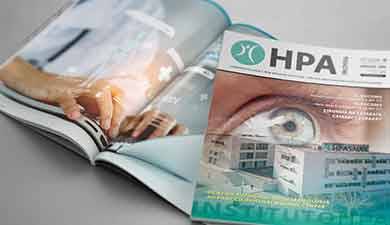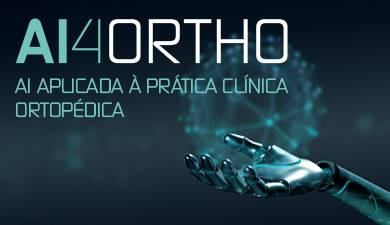Dr. Diogo Silva Gomes
Orthopaedic Surgeon

Dr.ª Maria Miguel Carvalho
Orthopaedic Surgeon

Arthroscopy diagnosis and treatment of shoulder pathology
HPA Magazine 11
Pain is the main complaint related to the shoulder, and it is also the main reason for patients seeking medical help. Shoulder pain may be due to any of the anatomical structures that make up the shoulder. Any pathology that reaches the complex shoulder joint becomes highly uncomfortable when performing daily tasks. The results of both the diagnosis and treatment of problems related to the shoulder are greatly improved by Arthroscopy.

The shoulder is a very complex joint. It is the joint with the greatest mobility in the human body. All hand movements which are essential for any activity of our daily lives, are controlled by the shoulder.
Any pathology that affects this complex shoulder joint becomes highly uncomfortable when accomplishing simpler day-to-day tasks, mainly due to associated pain, but often also incapacitating from a functional point of view, for example, dressing/undressing and personal hygiene.
In order to have a healthy shoulder the integrity and correct functioning of all the anatomical structures involved is indispensable.
Pain is the main complaint related to the shoulder, and it is also the main reason for the patient to seek medical help. Shoulder pain can be attributed to any of the anatomical structures of the shoulder. Depending on age, and whether the pain is associated with trauma, several pathologies should be considered.
The most frequent pathologies are: tendon injuries (inflammation, calcification or rupture) of the rotator cuff (supraspinatus, infraspinatus, subscapularis), inflammation of the subacromial bursa with eventual mechanical conflict (subacromial impingement syndrome), joint cartilage lesions involving the humeral head and the glenoid cavity on the shoulder blade (arthrosis), capsule lesions and ligaments that stabilise the shoulder (dislocation).
Other problems such as adhesive capsulitis (or frozen shoulder), lesions of the long head of the biceps, minor instability, acromioclavicular joint pathologies, among others, are less frequent, more difficult to diagnose, where complementary diagnosis often gives us little information. In these cases the physical medical examination is fundamental for diagnosis and treatment.
There are also diseases where pain is referred to the shoulder but does not originate in the shoulder. This may be the case with diseases of the cervical spine, inflammation of the nerves that emerge from the cervical spine, as well as pathologies originating in the lungs or even in the heart.
Nowadays, combining the ever growing knowledge of the anatomy and physiology of shoulder diseases associated with the evolution of complementary means of diagnosis, a better and more accurate diagnosis of these pathologies and consequently of their treatment is possible.
Arthroscopy of the shoulder which first began in the 20th century, has greatly improved the ability to diagnose and treat problems of the shoulder joint, leading to a very significant improvement in the results obtained.
Arthroscopy of the shoulder which first began in the 20th century, has greatly improved the ability to diagnose and treat problems of the shoulder joint, leading to a very significant improvement in the results obtained.
Arthroscopy is a mini-invasive technique where, through small incisions (approximately 0.5 cm), a camera and instruments are introduced. This allows direct visual access of all shoulder joint structures and simultaneous treatment of the lesion. The advantages is less tissue destruction to reach the affected joint, consequently, less postoperative pain and greater speed in the rehabilitation process when compared to conventional open surgery.
From an aesthetic point of view the small incisions usually become imperceptible at the end of a few months, avoiding large scars. Using this arthroscopic technique, it is possible to significantly increase diagnostic accuracy and treat pathologies/diseases. This is due to the direct visualization of the shoulder joint. Patients who were condemned to live their lives with the diagnosis of "tendinitis" began to see their lesions diagnosed and treated.
There are lesions however where classic open surgery remains necessary, due to the inherent pathology and necessary technique (fixation of fractures or arthroplasty, for example).
However, it is important to point out that surgery is not always necessary in the treatment of most pathologies of the shoulder. However, the diagnosis of non-surgical treatment is complex and must be address with additional differentiated care when compared to surgical treatment.
Following the highly diverse areas of Orthopaedics in recent years, the Hospital Particular do Algarve has since 2014 an Orthopaedic Consultation specifically dedicated to shoulder and elbow pathology.
This consultation was first initiated by Dr Diogo Silva Gomes and now also Dr Maria Miguel Carvalho is working in this area of Orthopaedics. This consultation is dedicated to the diagnosis and treatment of all injuries involving the complex shoulder joint, namely in the treatment of fractures, sports injuries, arthrosis or ligament and tendon injuries.
The unit is equipped to perform treatment of shoulder pathologies, both non-surgical and surgical (open or arthroscopic), always using the latest techniques and technology available.
The Shoulder and Elbow Consultation takes place every Wednesday at Gambelas Hospital and Thursdays at the Alvor Hospital with Dr Maria Miguel Carvalho and monthly at the Gambelas Hospital with Dr Diogo Silva Gomes.
Combining theoretical knowledge with technical experience, this specialised team manages to offer the latest treatment available, in all areas of shoulder pathology.
Most frequent arthroscopic surgery
- Rotator cuff tendon rupture;
- Subacromial impingement syndrome;
- Calcified tendinopathy of the rotator cuff;
- Instability and dislocation of the shoulder (some cases);
- Dislocations of the acromioclavicular joint;
- Frozen shoulder.
Most frequent open surgery
- Shoulder fractures (osteosynthesis or arthroplasty);
- Shoulder arthrosis (anatomical or reverse arthroplasty);
- Instability and dislocation of the shoulder (some cases).









